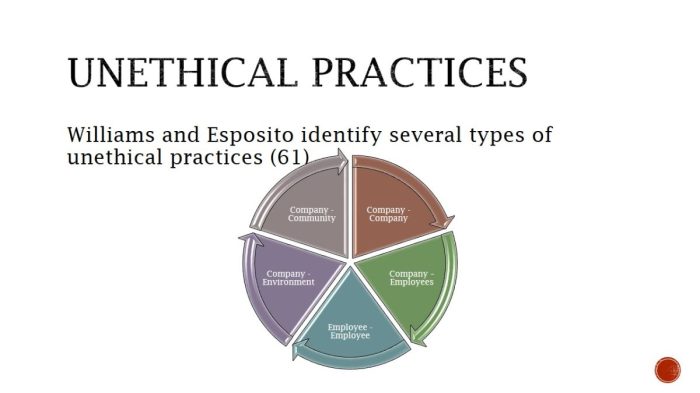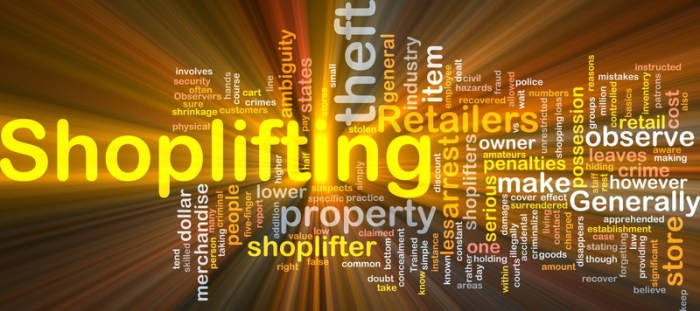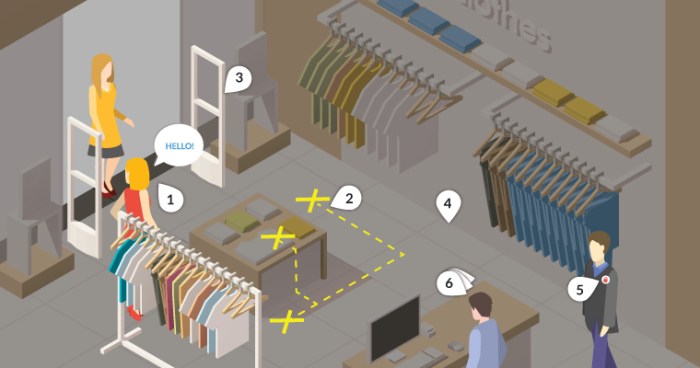
Are elements of shoplifting stop required by law – Shoplifting Stops: Are Legal Elements Required? This question delves into the intricate legal landscape surrounding shoplifting detentions, exploring the delicate balance between protecting businesses and safeguarding individual rights. Understanding the legal requirements for a lawful stop and detention is crucial for both businesses and individuals, as it ensures fairness and transparency in the legal process.
This exploration delves into the essential legal elements that must be present for a shoplifting stop to be deemed lawful, examining the legal basis for these actions, the specific requirements for reasonable suspicion and probable cause, and the rights of individuals who are detained. We will also analyze the potential consequences of unlawful detentions and explore the ethical considerations surrounding shoplifting prevention strategies.
Legal Definition of Shoplifting

Shoplifting, also known as retail theft, is a criminal offense that involves the act of taking merchandise from a retail store without paying for it. It’s a common crime, with significant economic and social implications.
To successfully prosecute someone for shoplifting, the prosecution must prove beyond a reasonable doubt that the accused:
Elements of Shoplifting
The elements required to prove shoplifting vary slightly depending on the jurisdiction, but generally include the following:
- Intent to Deprive: The accused must have acted intentionally, with the purpose of permanently depriving the store of its property. This can be shown through actions like concealing the merchandise, altering price tags, or removing security tags.
- Taking Possession: The accused must have taken physical possession of the merchandise. This can be demonstrated by holding, carrying, or placing the item in a bag or pocket.
- Without Payment: The accused must have taken the merchandise without paying for it. This means the accused did not make any attempt to pay for the item, or they made an attempt but did not complete the transaction.
- From a Retail Store: The merchandise must have been taken from a retail store, which is a place where goods are sold to the public. This excludes private residences or other non-retail locations.
Difference Between Shoplifting and Other Offenses
Shoplifting is often confused with other related offenses like theft or larceny. While these offenses share similarities, there are key differences:
- Theft is a broader term that encompasses the unlawful taking of another person’s property, regardless of the location or circumstances. Shoplifting is a specific type of theft that occurs in retail stores.
- Larceny is another term for theft, but it often refers to the taking of property that is not from a person’s immediate presence. Shoplifting, in contrast, typically involves taking property directly from the store.
Legal Consequences of Shoplifting
The consequences of shoplifting vary based on the value of the stolen goods, the offender’s criminal history, and the specific laws of the jurisdiction. In general, shoplifting is a misdemeanor offense, but it can be elevated to a felony in cases involving substantial amounts of stolen goods.
- Fines: Individuals convicted of shoplifting may face fines ranging from a few hundred dollars to several thousand dollars, depending on the severity of the offense.
- Jail Time: Depending on the value of the stolen goods and the offender’s criminal history, jail time can range from a few days to several months.
- Probation: In some cases, individuals may be sentenced to probation, which involves supervision and compliance with certain conditions.
- Community Service: As part of a sentence, individuals may be required to perform community service, which can involve working in a charitable organization or participating in public service projects.
- Criminal Record: A conviction for shoplifting can result in a criminal record, which can have lasting consequences, such as difficulty obtaining employment or housing.
Intent and Actus Reus
To understand the legal definition of shoplifting, it is essential to understand the two core elements of any crime: intent and actus reus. Intent refers to the mental state of the accused, while actus reus describes the physical act or conduct that constitutes the crime.
Intent in Shoplifting
Intent is a crucial element in shoplifting. It is not enough to simply take an item from a store; the prosecution must prove that the accused had the specific intent to deprive the store of the item’s possession. This intent is often referred to as the “intent to deprive” element.
- The accused must have acted intentionally, meaning they knowingly and willingly took the item.
- The accused must have intended to permanently deprive the store of the item, not just temporarily borrow it.
Actus Reus of Shoplifting
The actus reus of shoplifting involves the physical act of taking possession of the item with the intent to deprive the store of it. This can include a variety of actions, such as:
- Concealing an item in clothing or a bag.
- Altering price tags or labels on items.
- Leaving the store with an item without paying for it.
Examples of Shoplifting and Non-Shoplifting Actions, Are elements of shoplifting stop required by law
- Shoplifting: A person concealing a bottle of perfume in their bag and leaving the store without paying for it.
- Shoplifting: A person switching the price tag on a designer handbag with a cheaper item’s tag and paying for it at the lower price.
- Not Shoplifting: A person accidentally walking out of a store with a forgotten item.
- Not Shoplifting: A person taking an item off the shelf to examine it, but then returning it to the shelf.
Legal Requirements for Stop and Detention
The legal framework surrounding shoplifting stops and detentions is crucial for balancing the rights of individuals with the need to deter theft. This section delves into the legal basis for such actions, examining the requirements for lawful detention, and providing examples to illustrate these principles.
Reasonable Suspicion and Probable Cause
The legal justification for detaining someone suspected of shoplifting rests on the concepts of reasonable suspicion and probable cause. These legal standards are essential to ensure that detentions are not arbitrary or based on mere suspicion.
- Reasonable Suspicion: This standard, lower than probable cause, allows law enforcement or store security personnel to briefly detain an individual if they have a reasonable belief that the person is engaging in or has engaged in criminal activity, such as shoplifting. This belief must be based on specific and articulable facts.
- Probable Cause: A higher standard than reasonable suspicion, probable cause exists when there is a fair probability that a crime has been committed and that the individual detained is responsible. This standard typically requires more evidence, such as eyewitness testimony, physical evidence, or a confession.
Examples of Justified and Unjustified Stops
To better understand the application of these legal standards, it is helpful to consider examples of situations where a shoplifting stop would be justified and when it would not.
- Justified Stop: A store security officer observes an individual concealing merchandise in their clothing, acting suspiciously, and attempting to leave the store without paying. The officer has reasonable suspicion to detain the individual for questioning.
- Unjustified Stop: A store employee sees an individual browsing through merchandise, but there is no evidence of any suspicious behavior or attempt to conceal items. Detaining the individual based solely on their race or appearance would be unjustified and could constitute racial profiling.
Statutory and Case Law
The legal framework for shoplifting stops and detentions varies by jurisdiction, but generally relies on a combination of statutory law and case law.
- Statutory Law: Many states have specific statutes that address shoplifting and provide legal authority for merchants to detain individuals suspected of shoplifting. These statutes often define shoplifting, Artikel the circumstances under which a merchant can detain an individual, and specify the duration of the detention.
- Case Law: Courts have also developed case law that further clarifies the legal requirements for shoplifting stops and detentions. For example, courts have ruled on the scope of reasonable suspicion, the duration of lawful detention, and the proper procedures for conducting a shoplifting investigation.
Duration of Detention
The duration of a lawful detention for shoplifting is limited and must be reasonable under the circumstances. The detention should be brief and only last as long as necessary to investigate the suspected shoplifting.
- Reasonable Duration: Factors considered in determining whether the detention was reasonable include the nature of the suspected shoplifting, the amount of evidence available, and the time needed to contact law enforcement.
- Unreasonable Duration: If the detention is prolonged without sufficient justification, it may be considered unlawful and could result in legal action against the merchant.
Use of Force
Merchants or security personnel are generally not authorized to use physical force to detain a suspected shoplifter. However, there may be exceptions in situations where the individual poses a threat to themselves or others.
- Self-Defense: If a suspected shoplifter becomes violent or threatens to harm themselves or others, merchants or security personnel may use reasonable force to protect themselves and others.
- Prevention of Escape: In some cases, merchants or security personnel may be authorized to use force to prevent a suspected shoplifter from escaping. However, the force used must be proportionate to the threat posed by the individual.
Consequences of Unlawful Detention
Unlawful detention of a suspected shoplifter can have serious consequences for the merchant or security personnel involved.
- False Imprisonment: If an individual is detained without reasonable suspicion or probable cause, they may have a claim for false imprisonment.
- Civil Liability: Merchants or security personnel who unlawfully detain an individual may face civil liability for damages, including emotional distress, lost wages, and legal fees.
- Criminal Charges: In some cases, unlawful detention may also result in criminal charges, such as false arrest or unlawful imprisonment.
Rights of the Accused

Individuals accused of shoplifting have certain fundamental rights that are protected by law. Understanding these rights is crucial for ensuring a fair and just legal process.
Right to Remain Silent
The Fifth Amendment to the United States Constitution guarantees the right to remain silent. This means that individuals accused of shoplifting are not obligated to answer any questions from law enforcement or provide any information that could incriminate themselves. It is important to note that exercising this right does not imply guilt.
Right to Legal Counsel
The Sixth Amendment to the United States Constitution guarantees the right to legal counsel. This means that individuals accused of shoplifting have the right to have an attorney present during questioning, at any court hearings, and throughout the legal process. If an individual cannot afford an attorney, the court will appoint one to represent them.
Arrest and Detention
If a person is accused of shoplifting, law enforcement may arrest them. The process of arrest and detention for shoplifting typically involves the following steps:
* Detention: The individual may be detained by store security or law enforcement officers while the incident is investigated.
* Arrest: If probable cause exists, the individual may be formally arrested.
* Booking: The individual may be transported to a police station or jail for booking, which involves fingerprinting, photographing, and recording personal information.
* Bail or Release: The individual may be released on bail or their own recognizance, or they may be detained until a court hearing.
Role of Law Enforcement and the Legal System
Law enforcement officers play a critical role in investigating shoplifting cases. They may interview witnesses, gather evidence, and determine if there is sufficient evidence to support an arrest. The legal system, including the courts and prosecutors, is responsible for adjudicating shoplifting cases. Prosecutors decide whether to file criminal charges, and judges preside over court hearings and determine the outcome of the case.
Shoplifting Prevention Strategies
Businesses face the ongoing challenge of deterring shoplifting, which can significantly impact their profits and security. Effective shoplifting prevention strategies are crucial to mitigating these risks.
Security Measures
Implementing security measures is a fundamental aspect of shoplifting prevention. These measures aim to deter potential shoplifters and facilitate the apprehension of those who attempt to steal.
- Security Cameras: Surveillance systems with high-definition cameras are widely used to monitor store activity, capture evidence of shoplifting incidents, and deter potential theft.
- Security Guards: Visible security personnel can act as a deterrent, deterring potential shoplifters and responding to suspicious activity.
- Electronic Article Surveillance (EAS) Systems: EAS systems employ tags attached to merchandise, which trigger alarms when items pass through designated checkpoints. These systems help detect shoplifting attempts at the point of exit.
- Point-of-Sale (POS) Security: POS systems with integrated security features, such as transaction monitoring and inventory tracking, can help identify and prevent shoplifting by detecting discrepancies in sales data.
- Lighting: Well-lit stores deter shoplifting by making it more difficult for thieves to conceal their actions.
- Store Layout: Effective store layout, such as open floor plans and strategically placed merchandise, can reduce shoplifting opportunities by enhancing visibility and limiting blind spots.
Employee Training
Investing in employee training is crucial for successful shoplifting prevention. Trained employees are better equipped to identify and respond to potential shoplifting situations.
- Shoplifting Awareness: Employees should be trained to recognize common shoplifting techniques and signs of suspicious behavior.
- Loss Prevention Procedures: Employees should be familiar with the store’s loss prevention policies and procedures, including how to approach suspected shoplifters, document incidents, and collaborate with security personnel.
- Customer Service: Excellent customer service can contribute to a positive shopping experience and reduce the likelihood of shoplifting.
Effectiveness of Prevention Methods
The effectiveness of shoplifting prevention methods varies depending on factors such as the type of store, the level of investment, and the implementation strategy.
- Security Cameras: Cameras have proven to be effective in deterring shoplifting and providing evidence in investigations. However, their effectiveness can be limited if not strategically placed or if footage is not regularly monitored.
- Security Guards: The presence of security guards can act as a deterrent, but their effectiveness can depend on their training, visibility, and responsiveness.
- EAS Systems: EAS systems are generally effective in detecting shoplifting attempts at the point of exit. However, they can be bypassed by sophisticated shoplifters.
- Employee Training: Well-trained employees can play a significant role in preventing shoplifting by recognizing suspicious behavior and implementing loss prevention procedures. However, their effectiveness can be limited by factors such as staff turnover and lack of ongoing training.
Impact on Customer Experience
The implementation of shoplifting prevention strategies can have both positive and negative impacts on customer experience.
- Enhanced Security: Increased security measures can provide customers with a sense of safety and security.
- Privacy Concerns: Surveillance systems and security guards can raise privacy concerns for some customers.
- Customer Service: Effective employee training can enhance customer service and create a more positive shopping experience.
- Inconvenience: Some security measures, such as EAS systems, can cause inconvenience for customers, particularly if they trigger alarms unintentionally.
Comparison of Shoplifting Prevention Techniques
| Prevention Technique | Cost | Benefits |
|---|---|---|
| Security Cameras | High | Deterrence, evidence capture |
| Security Guards | Moderate to High | Deterrence, immediate response |
| EAS Systems | Moderate | Detection at point of exit |
| Employee Training | Moderate | Shoplifting awareness, loss prevention procedures |
| Lighting | Low | Enhanced visibility, deterrence |
| Store Layout | Low to Moderate | Reduced blind spots, enhanced visibility |
Social and Economic Impact of Shoplifting
Shoplifting, a prevalent issue in modern society, has far-reaching consequences, impacting businesses, consumers, and the overall well-being of communities. The act of stealing merchandise from retail stores not only results in financial losses but also contributes to a decline in public safety and erodes trust in commercial environments.
Financial Costs of Shoplifting
Shoplifting inflicts significant financial burdens on businesses, leading to a decline in profits and an increase in operational expenses. The costs associated with shoplifting are multifaceted, encompassing lost revenue, security measures, and legal proceedings.
- Lost Revenue: The most direct consequence of shoplifting is the loss of revenue resulting from stolen merchandise. The financial impact of shoplifting varies depending on the value of the stolen goods and the frequency of shoplifting incidents. A study by the National Retail Federation (NRF) revealed that shoplifting accounted for an estimated $94.5 billion in losses for retailers in 2022.
- Security Expenses: Retailers often invest heavily in security measures to deter shoplifting, such as surveillance cameras, security personnel, and electronic article surveillance (EAS) systems. These security measures add to the overall cost of doing business and reduce profit margins. The NRF estimates that retailers spend an average of $1.45 per $1,000 in sales on security measures, with the average cost of a shoplifting incident reaching $1,000.
- Legal Fees: When shoplifters are apprehended, businesses may incur legal fees associated with prosecuting the offenders. These expenses include court costs, attorney fees, and the time spent by employees in dealing with legal proceedings. The financial burden of legal fees can be substantial, particularly for small businesses with limited resources.
Impact on Consumers
Shoplifting has a direct impact on consumers, as businesses may pass on the costs of shoplifting to customers in the form of higher prices. Additionally, shoplifting can lead to a decrease in the availability of products, as retailers may be forced to reduce inventory levels to minimize losses.
- Higher Prices: To compensate for lost revenue and increased security expenses, retailers may increase prices for their products, ultimately impacting consumers’ wallets. Higher prices can disproportionately affect low-income households, making essential goods less accessible.
- Product Shortages: When retailers experience significant losses due to shoplifting, they may reduce inventory levels to mitigate financial risks. This can lead to product shortages, making it difficult for consumers to find the items they need, especially during peak seasons or for specific products.
Ethical Considerations
Shoplifting is not only a financial issue but also raises ethical concerns. It is considered a form of theft and undermines the fundamental principles of honesty and fairness in society.
- Dishonesty and Unfairness: Shoplifting is a form of dishonesty, as it involves stealing merchandise without paying for it. It is unfair to businesses and consumers who pay for their goods, as shoplifters are essentially benefiting from the efforts of others without contributing their fair share.
- Impact on Community Trust: Shoplifting can erode trust in commercial environments, making people hesitant to shop or work in areas with a high prevalence of shoplifting. This can negatively impact local economies and create a sense of insecurity for both businesses and consumers.
Closing Notes: Are Elements Of Shoplifting Stop Required By Law

Navigating the legal complexities of shoplifting stops requires a thorough understanding of the legal framework governing these actions. Businesses must implement effective shoplifting prevention strategies while adhering to legal requirements, ensuring fairness and transparency. Individuals, on the other hand, should be aware of their rights during a shoplifting stop and understand the process of legal defense if accused. By navigating this delicate balance, we can foster a safer and more just environment for both businesses and individuals.
FAQs
What are the consequences of a false shoplifting accusation?
A false shoplifting accusation can have serious consequences, including reputational damage, legal fees, and potential emotional distress. It is important to understand the legal process and seek legal counsel if you are wrongly accused.
Can I be detained for a long time during a shoplifting investigation?
The length of detention during a shoplifting investigation depends on the circumstances and the jurisdiction. Generally, the detention should be reasonable and based on probable cause. If you believe your detention is excessive, you should consult with an attorney.